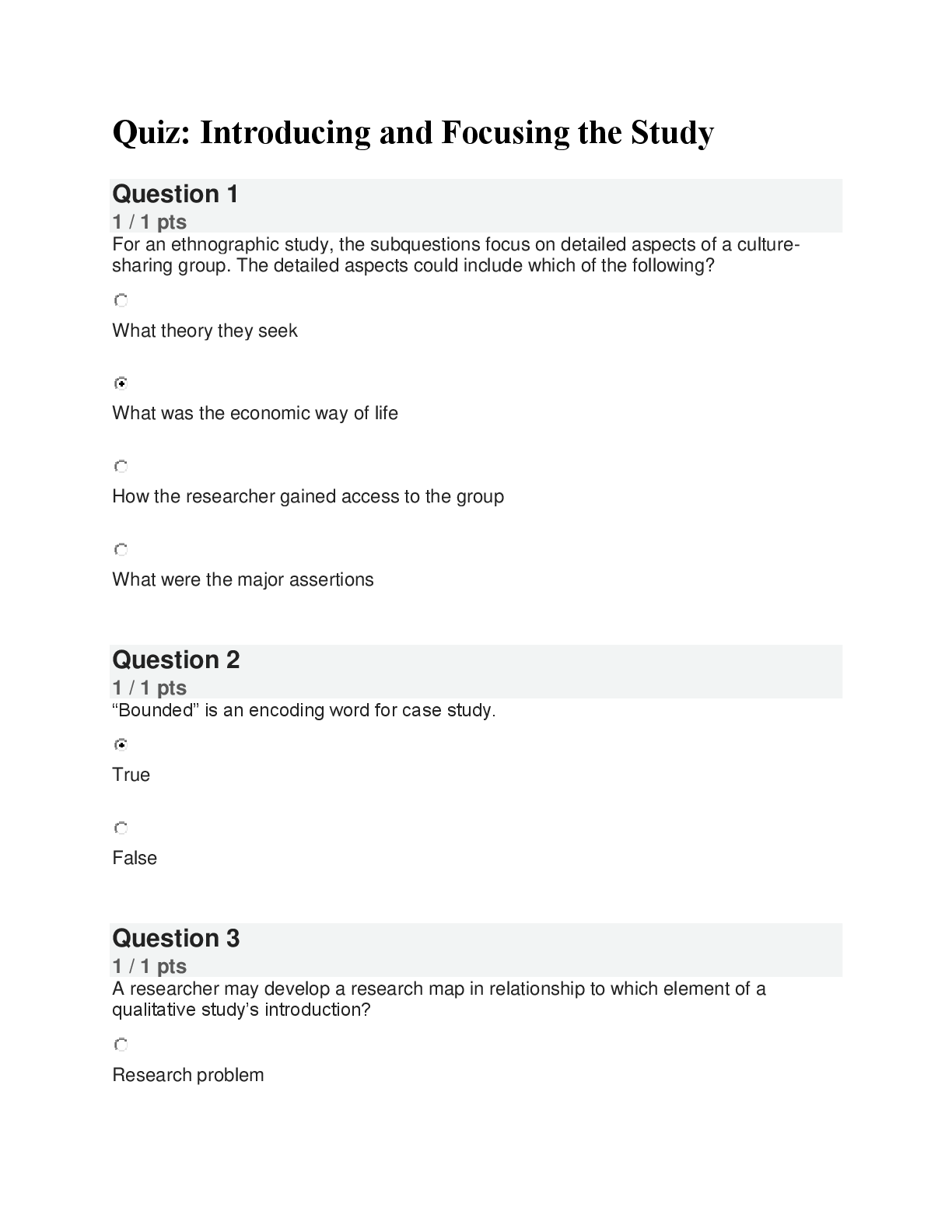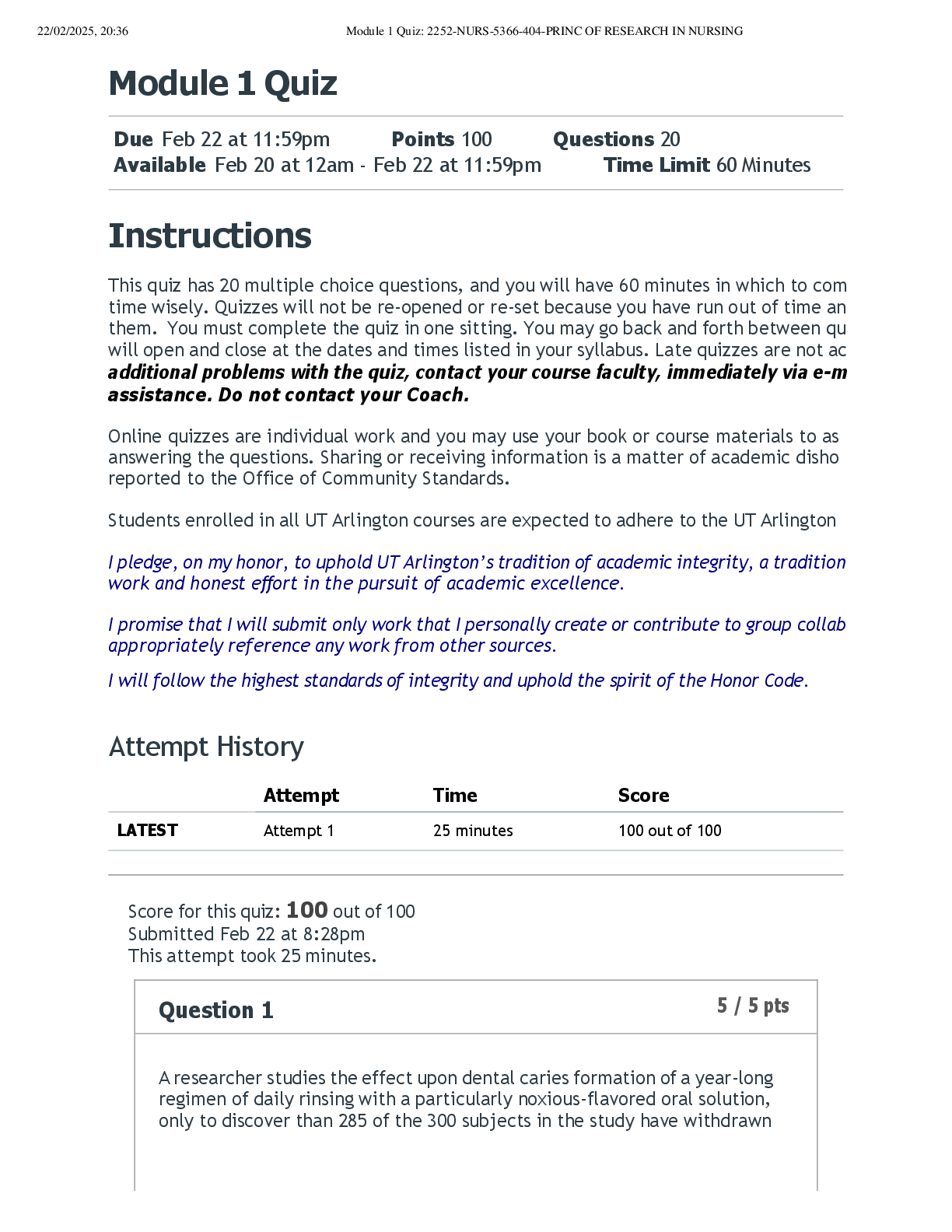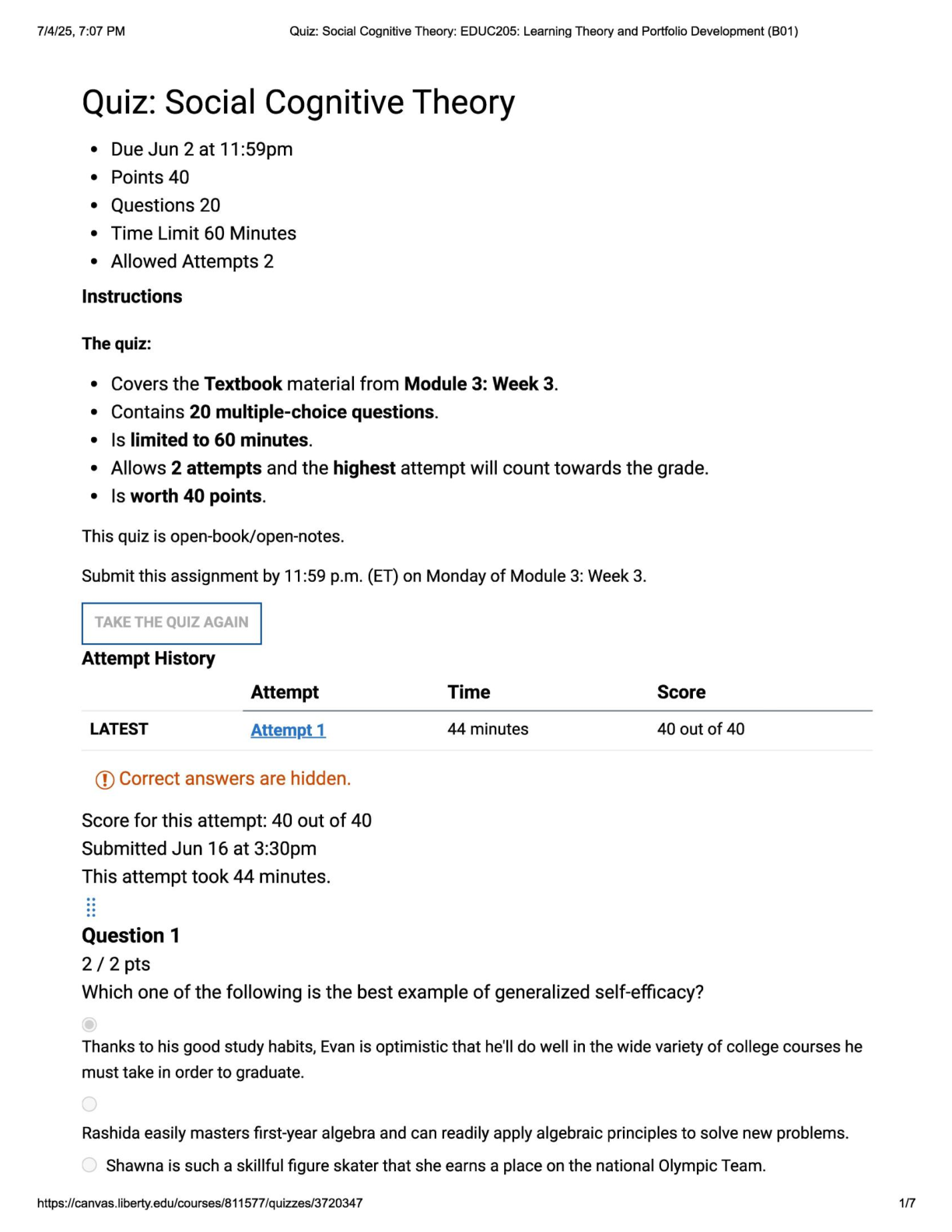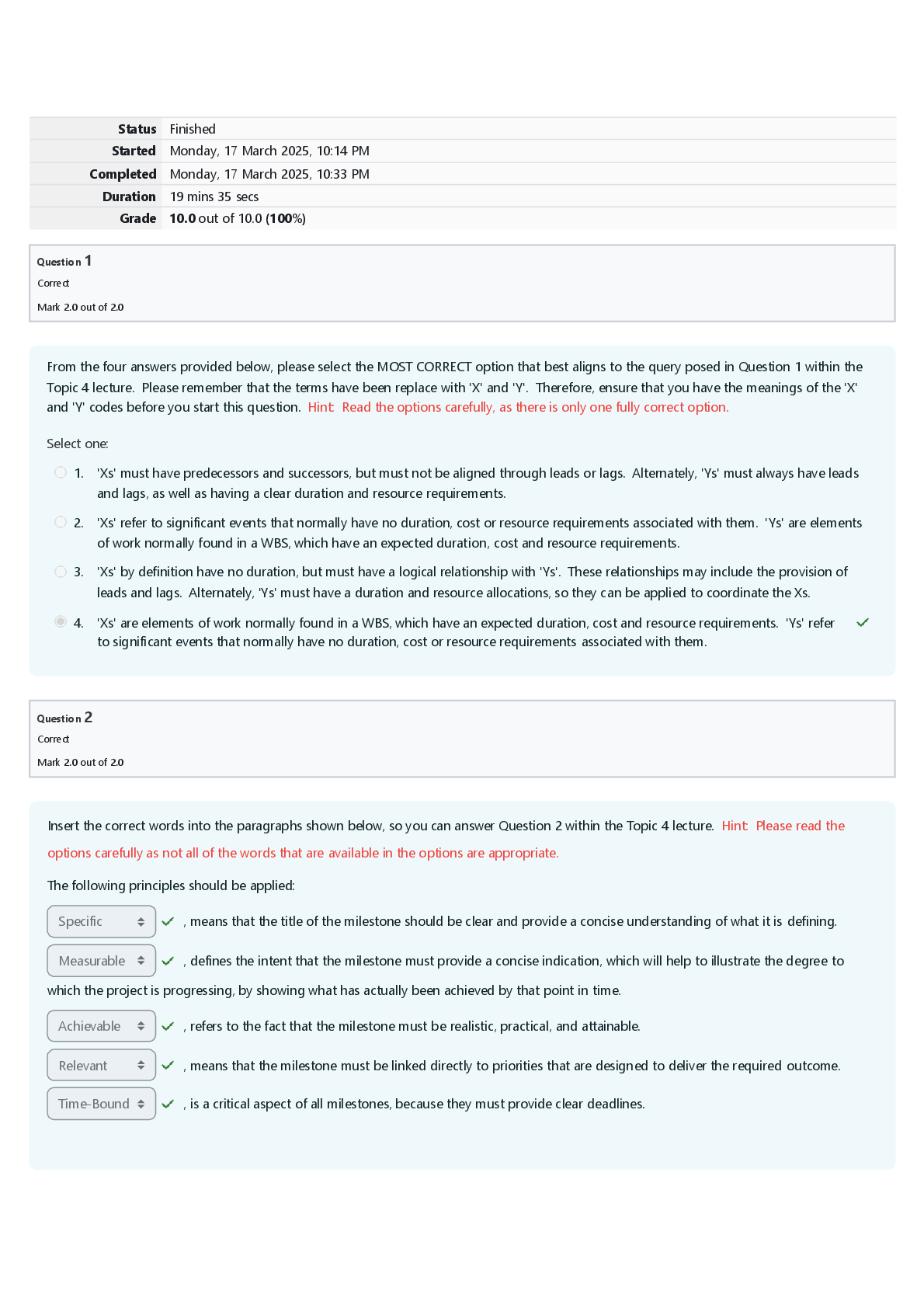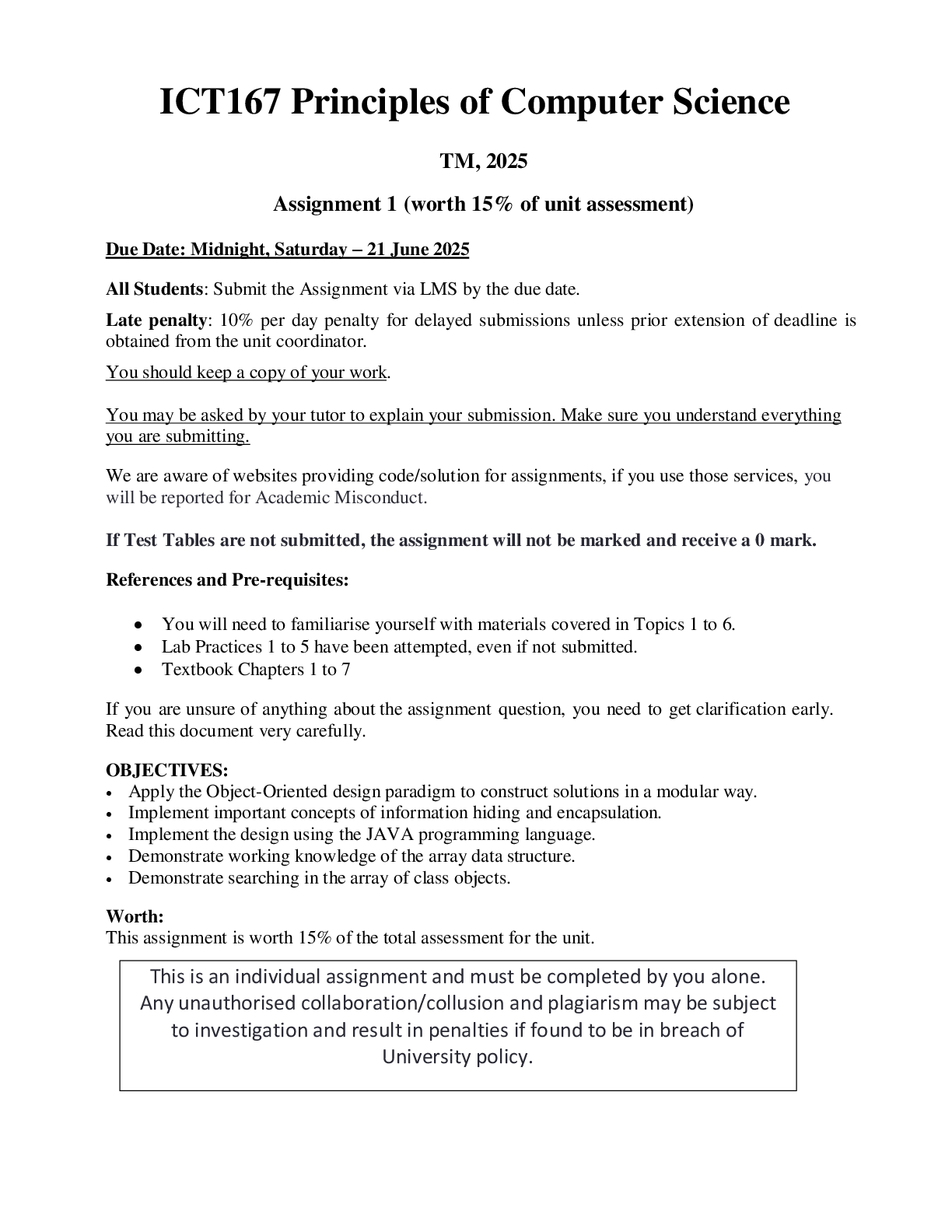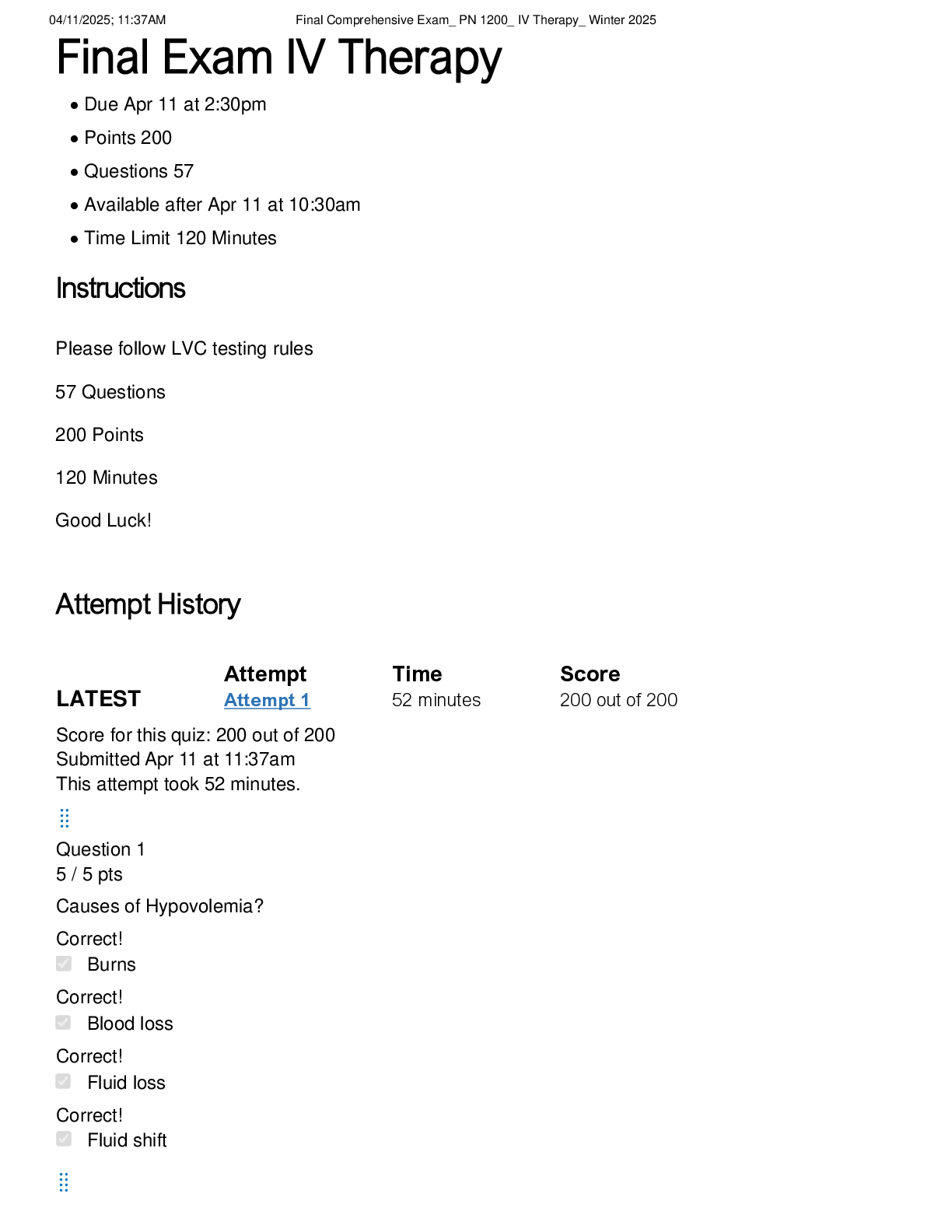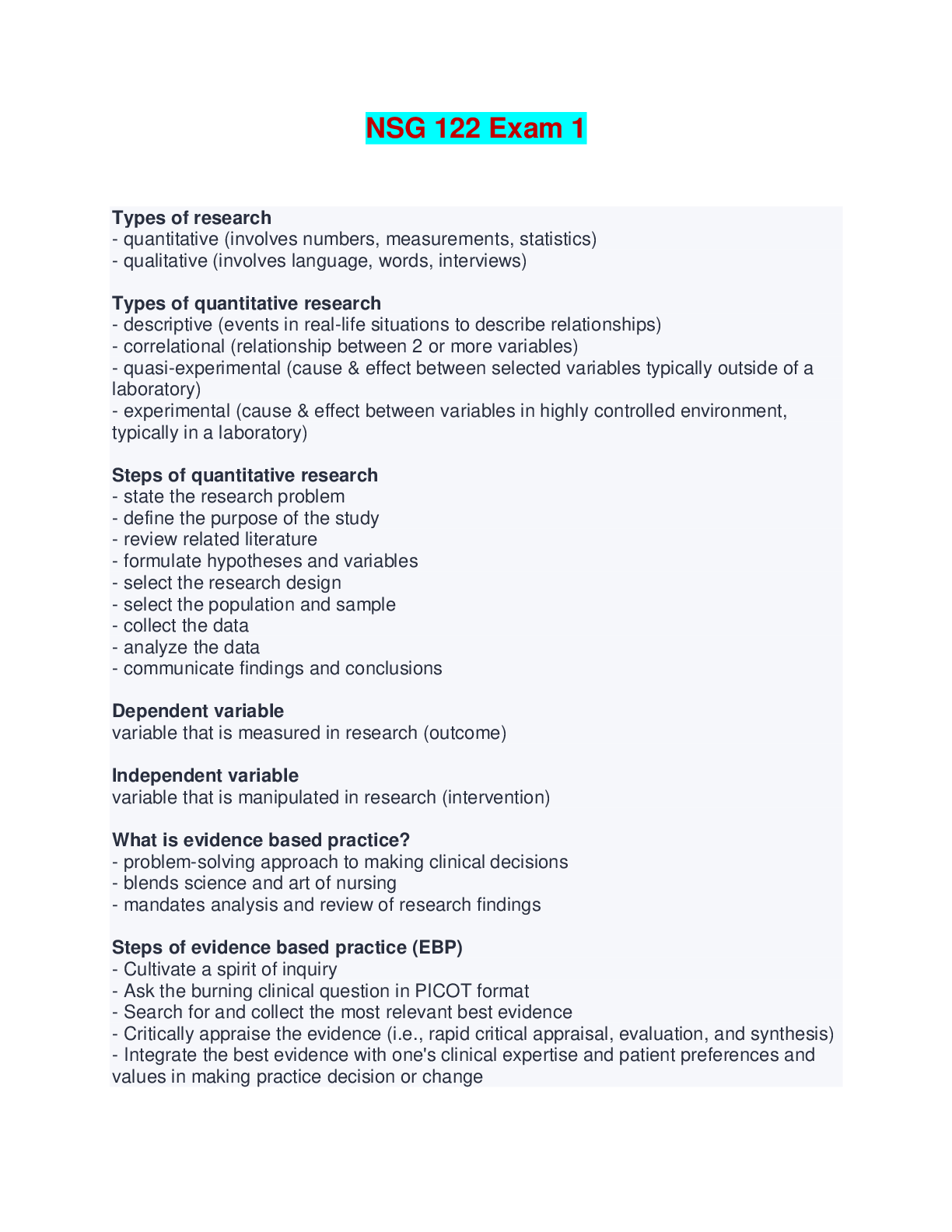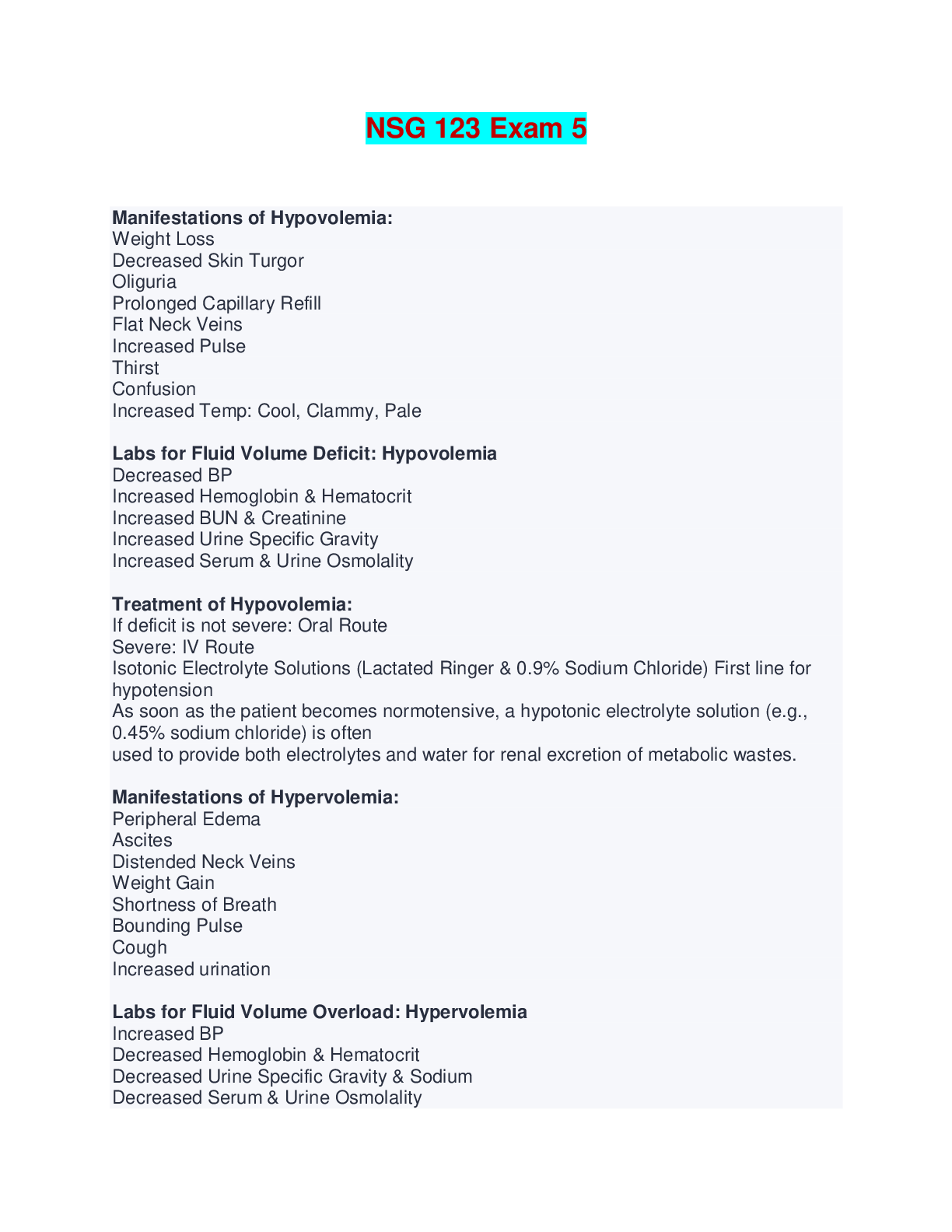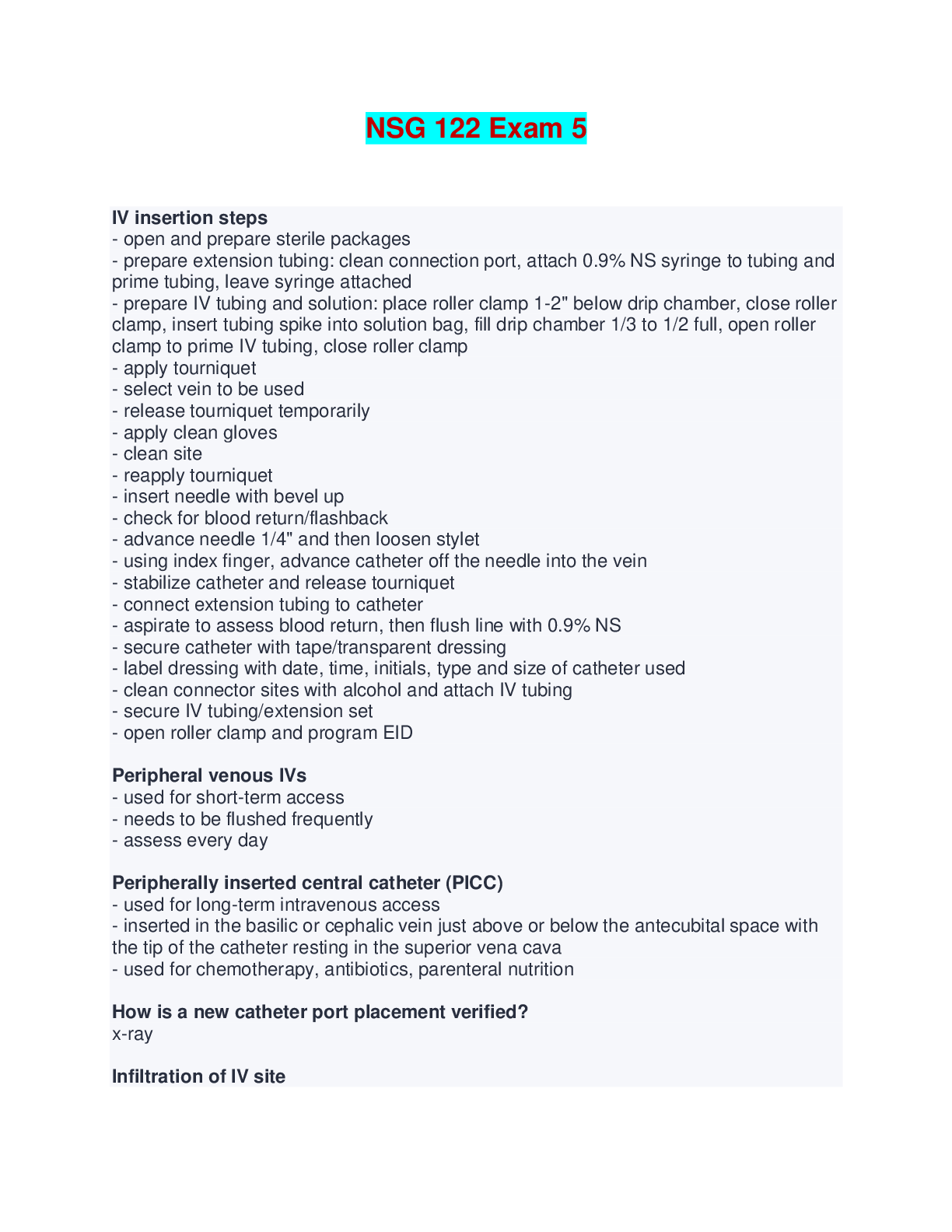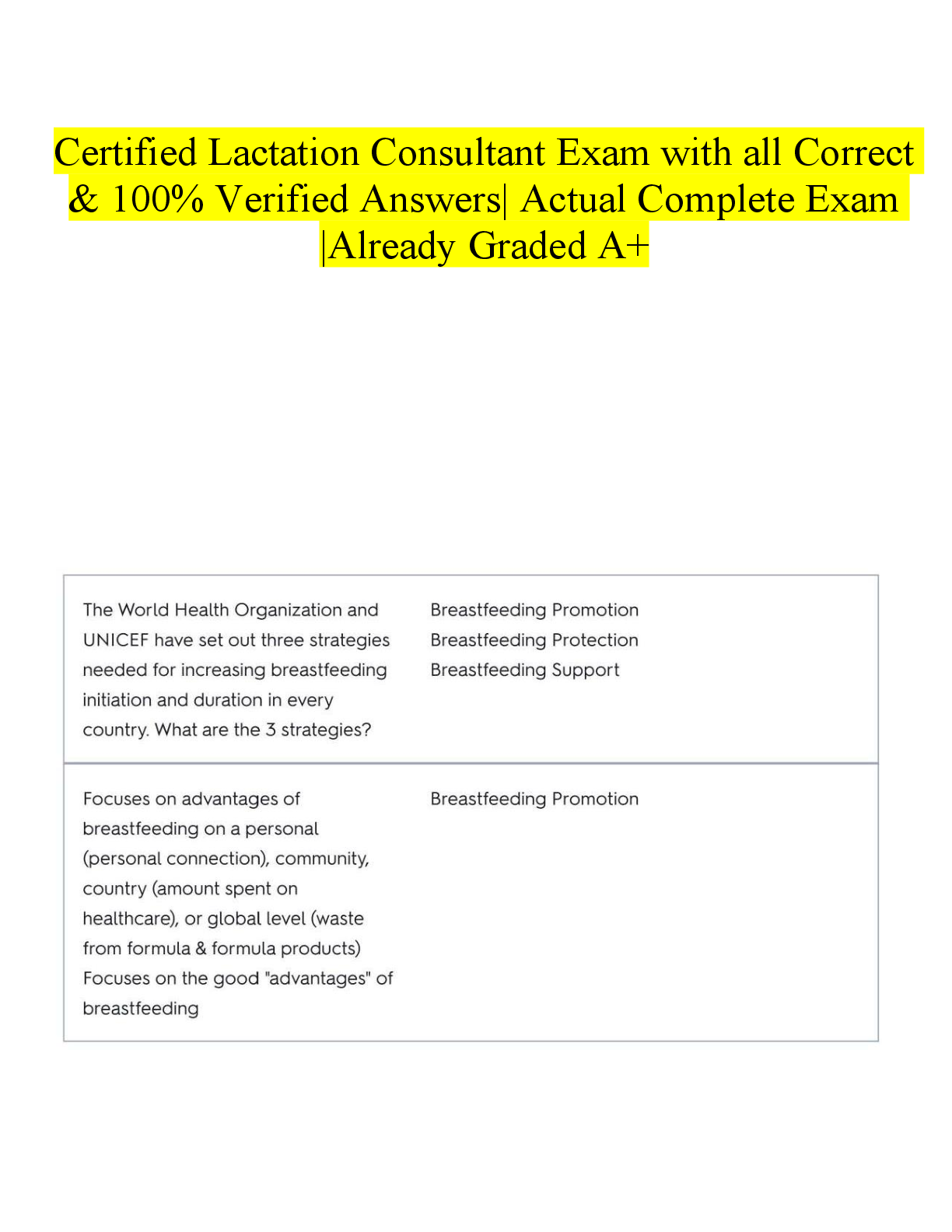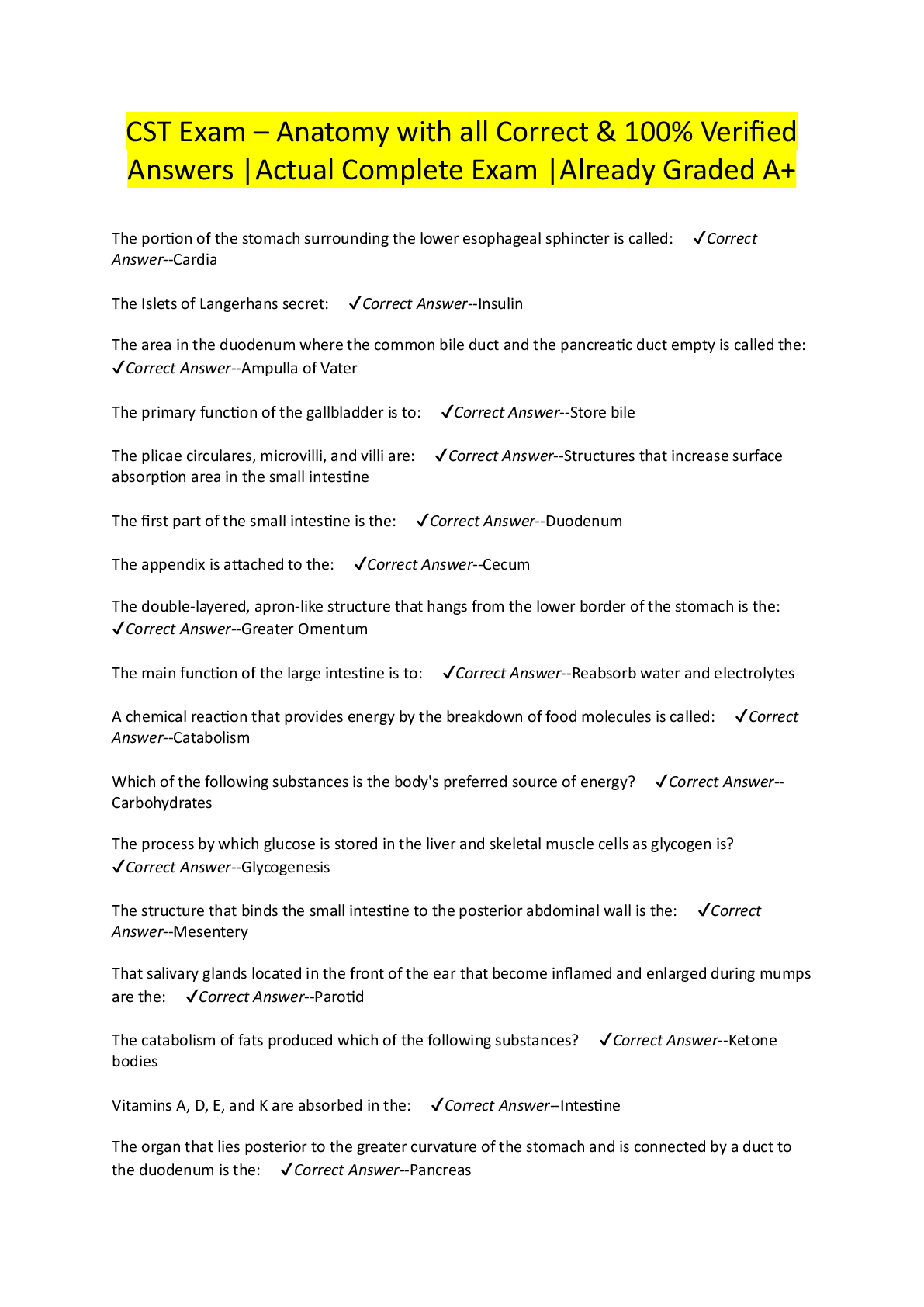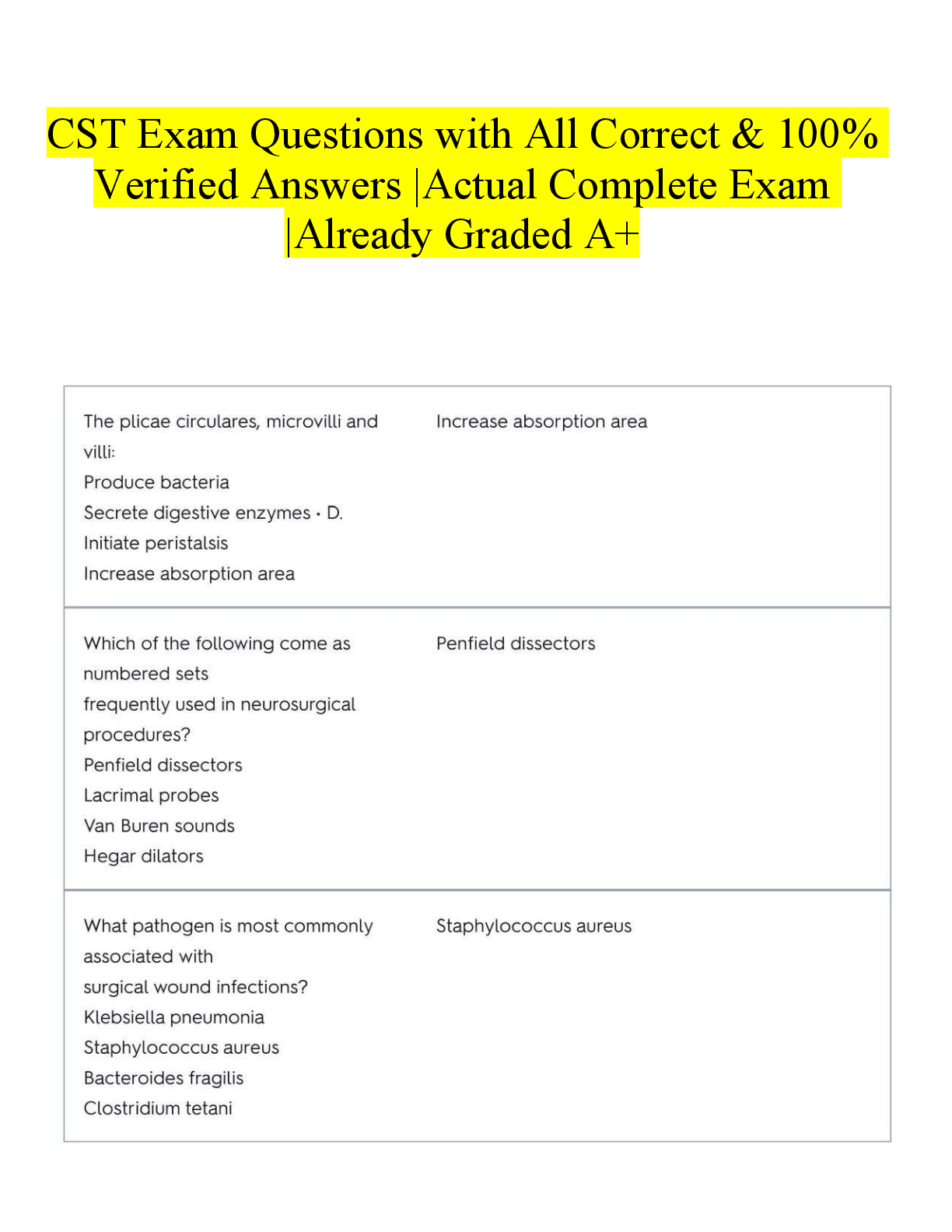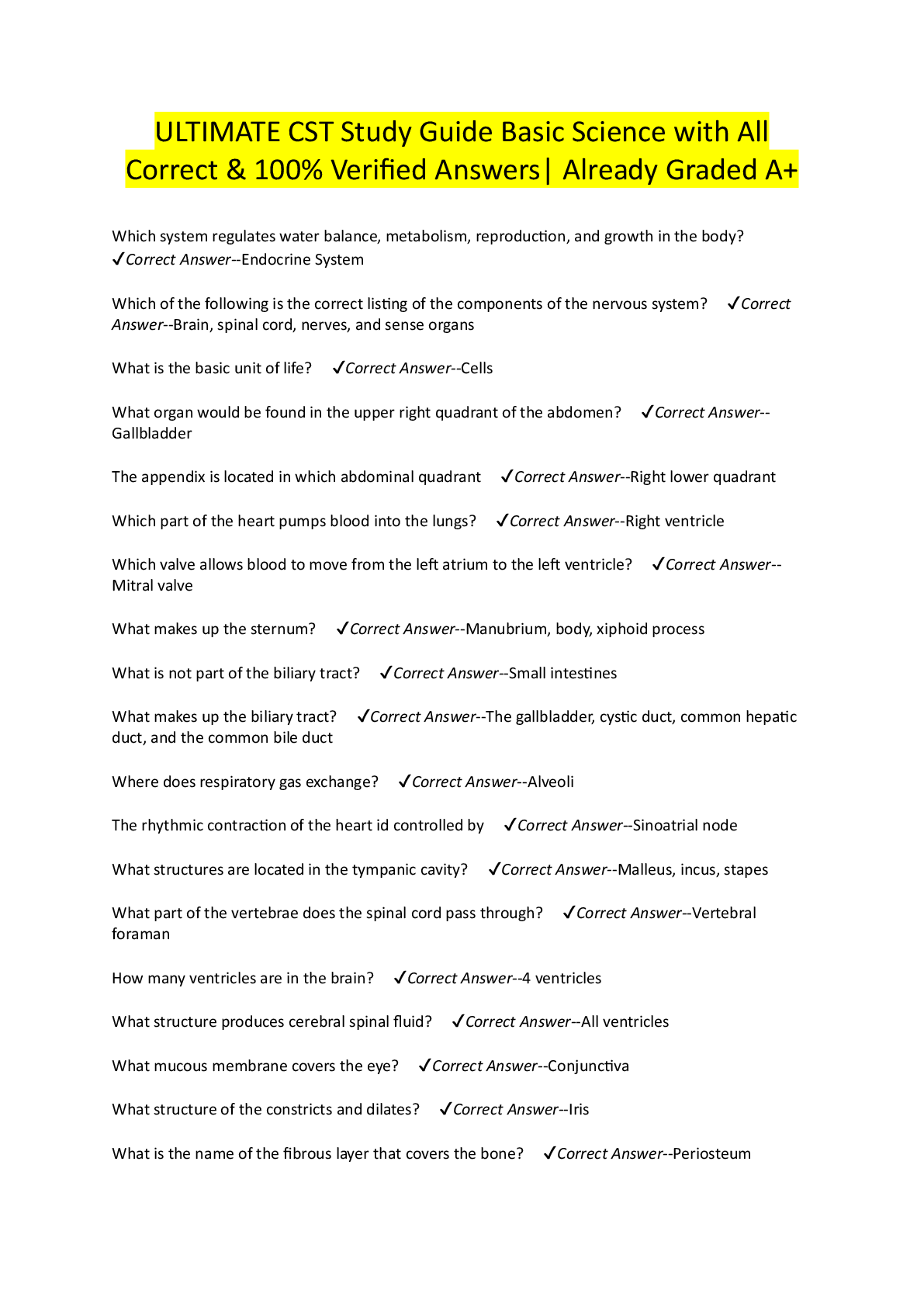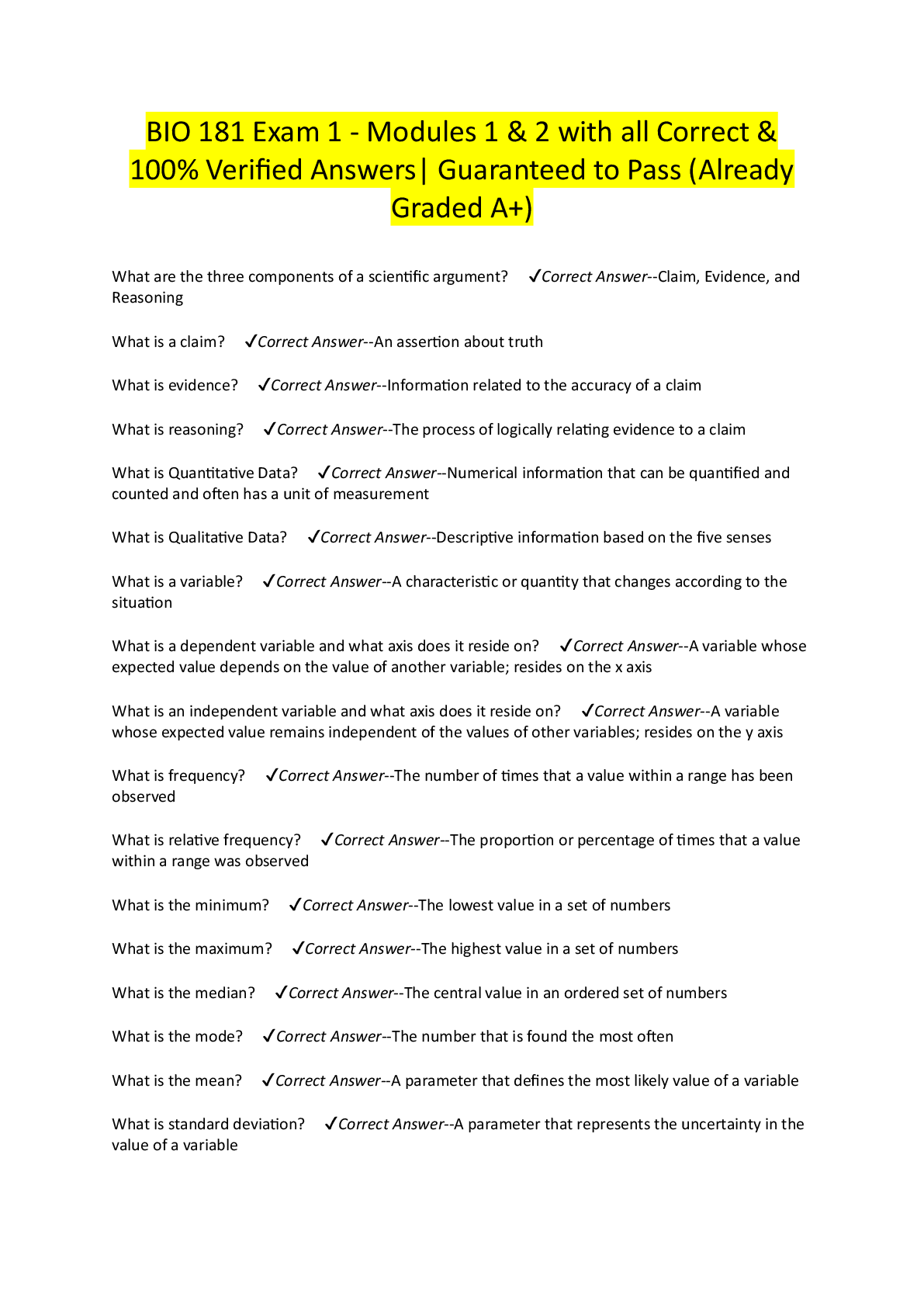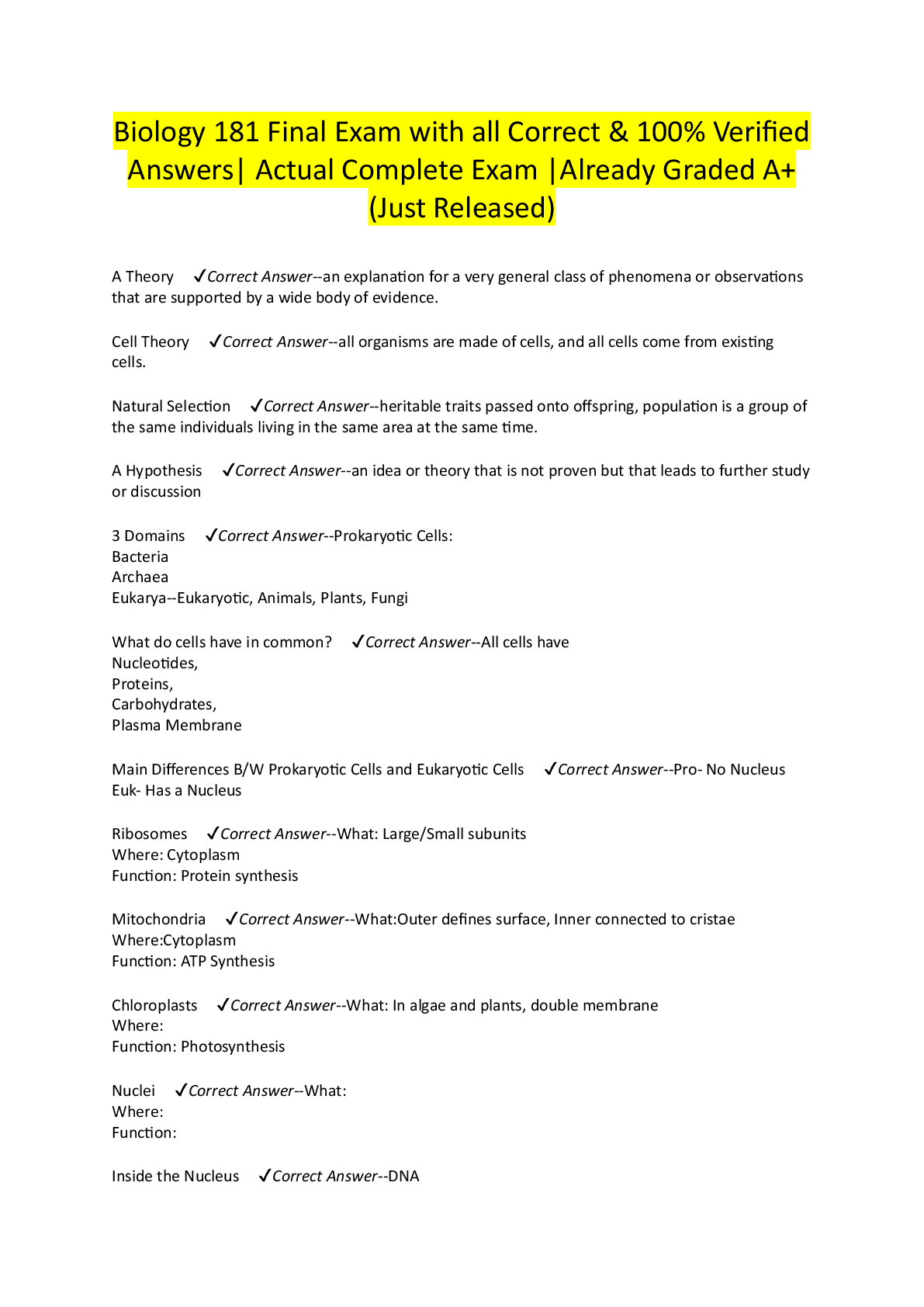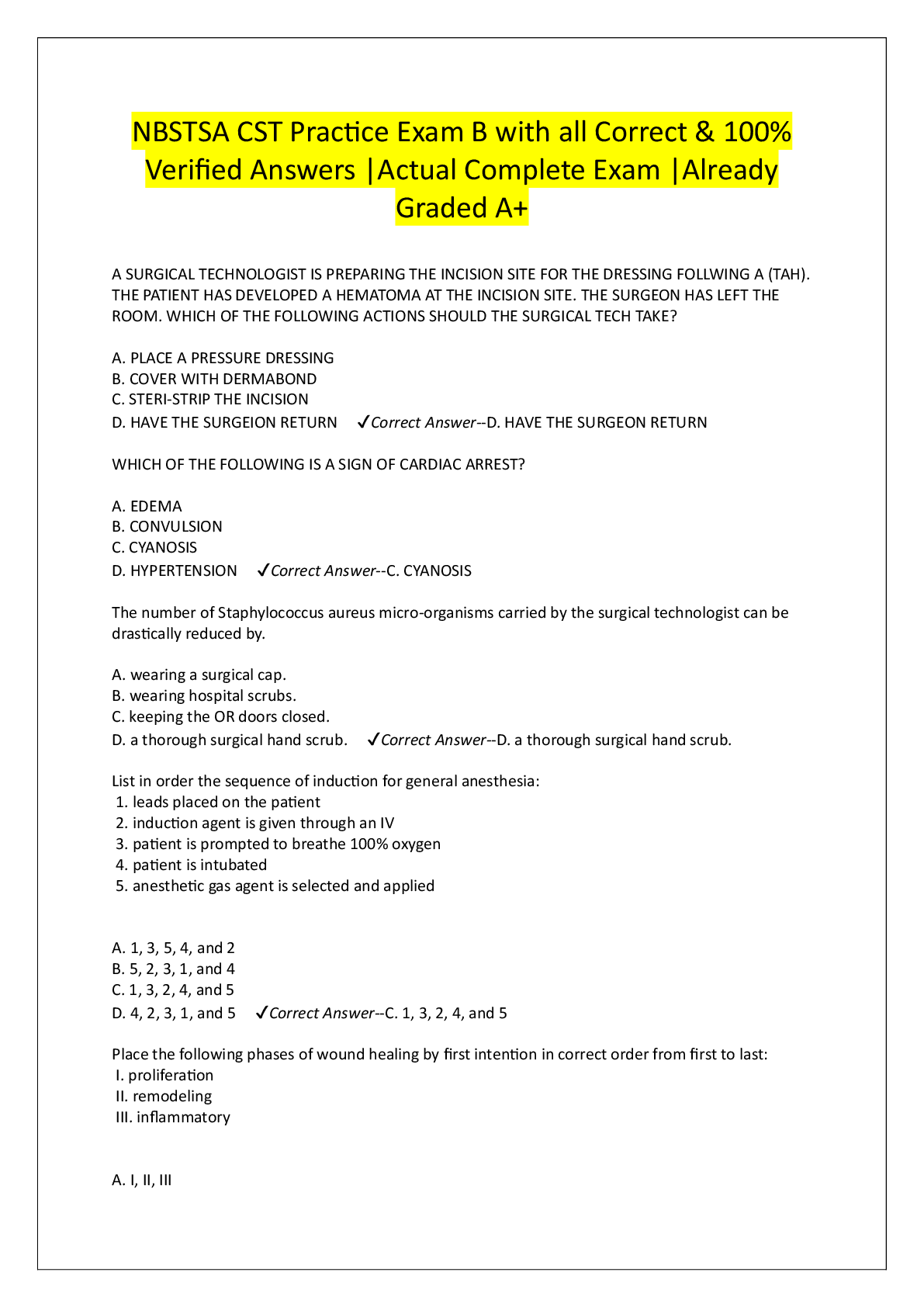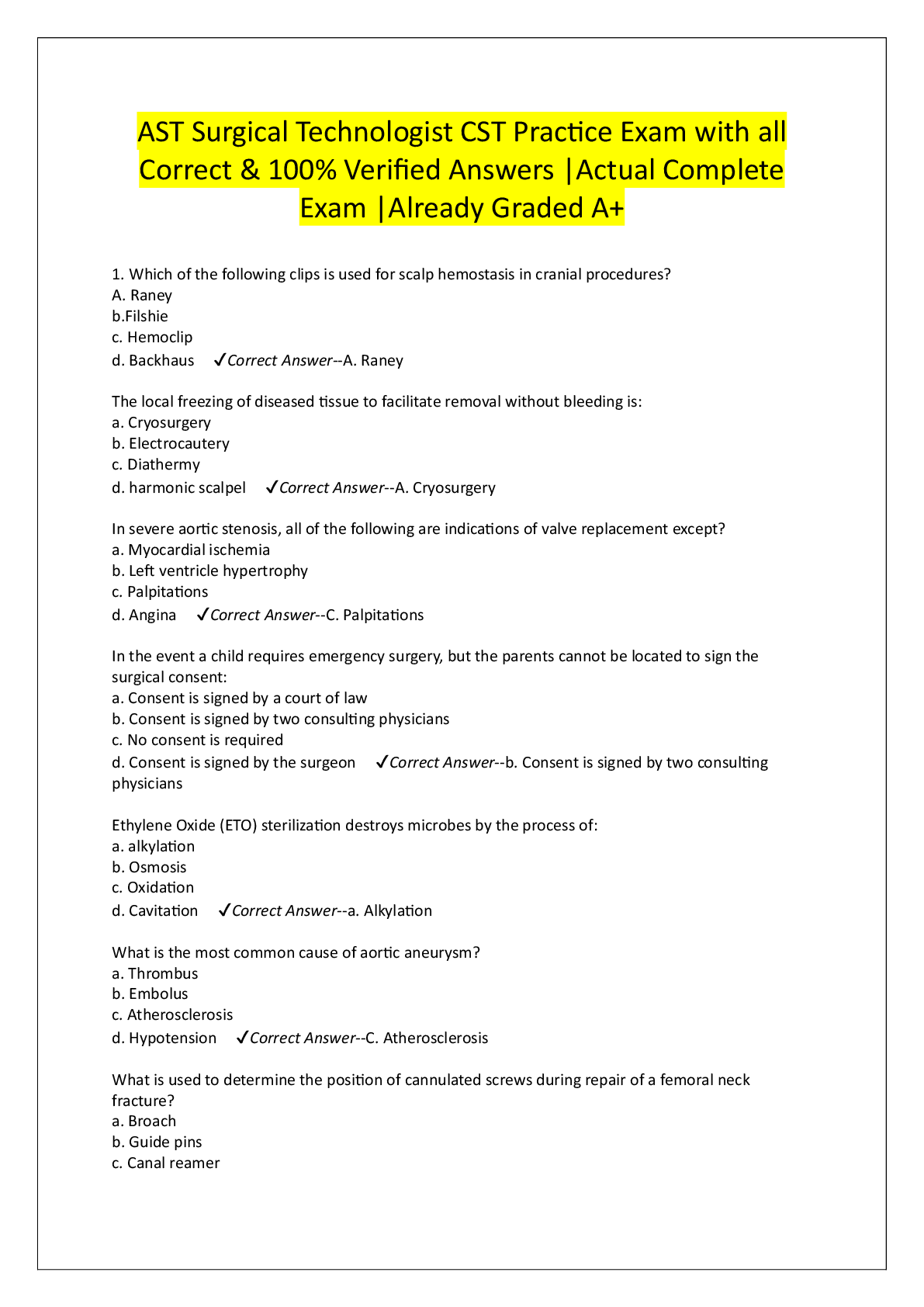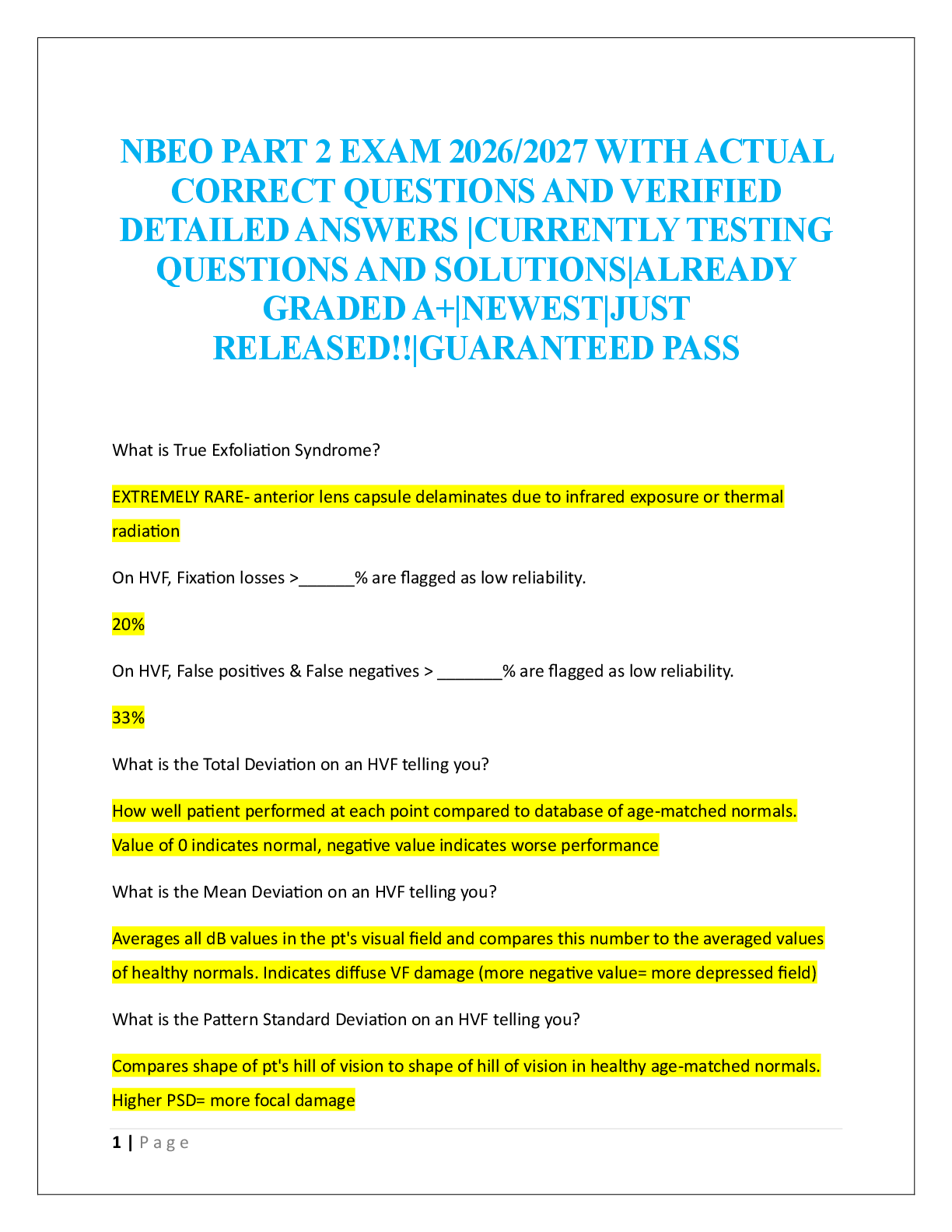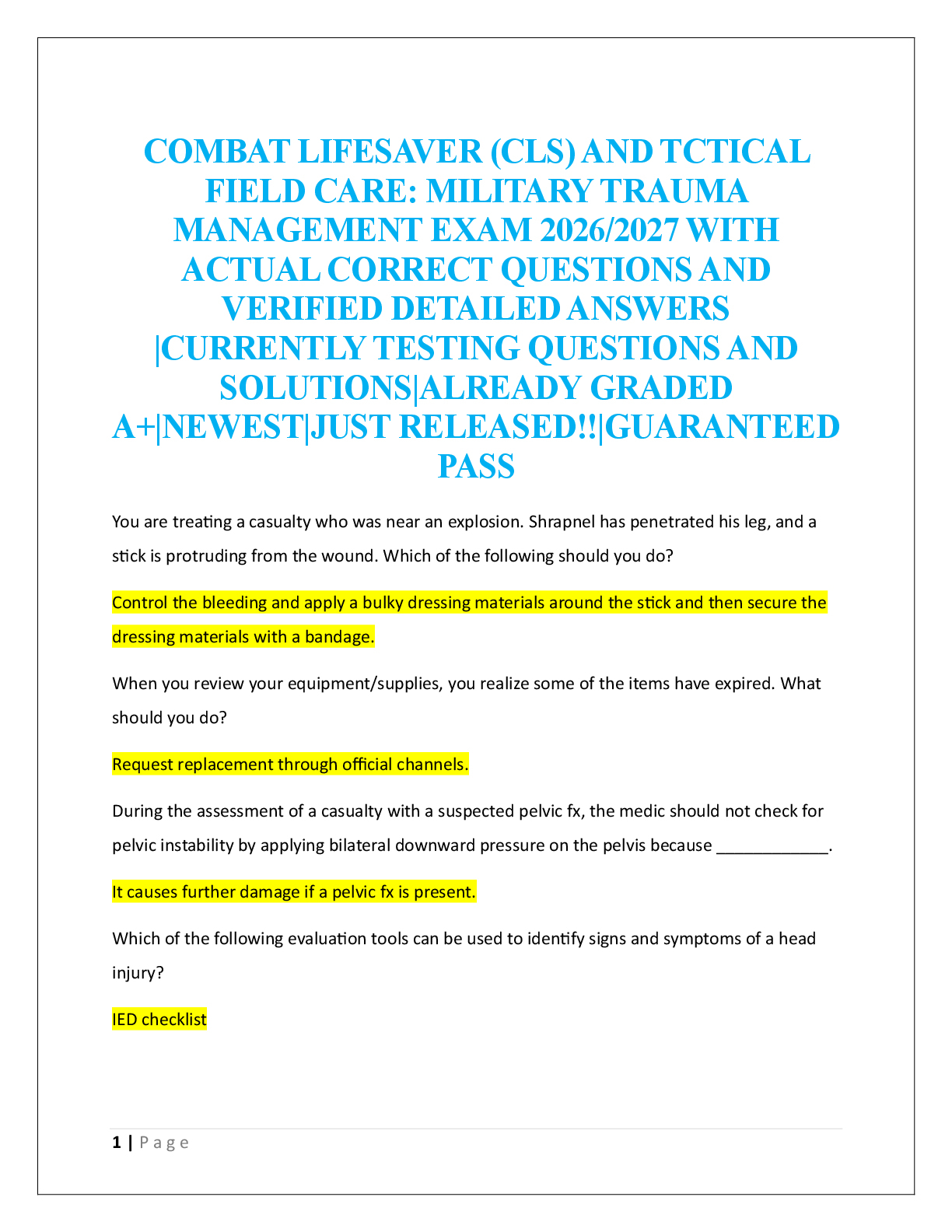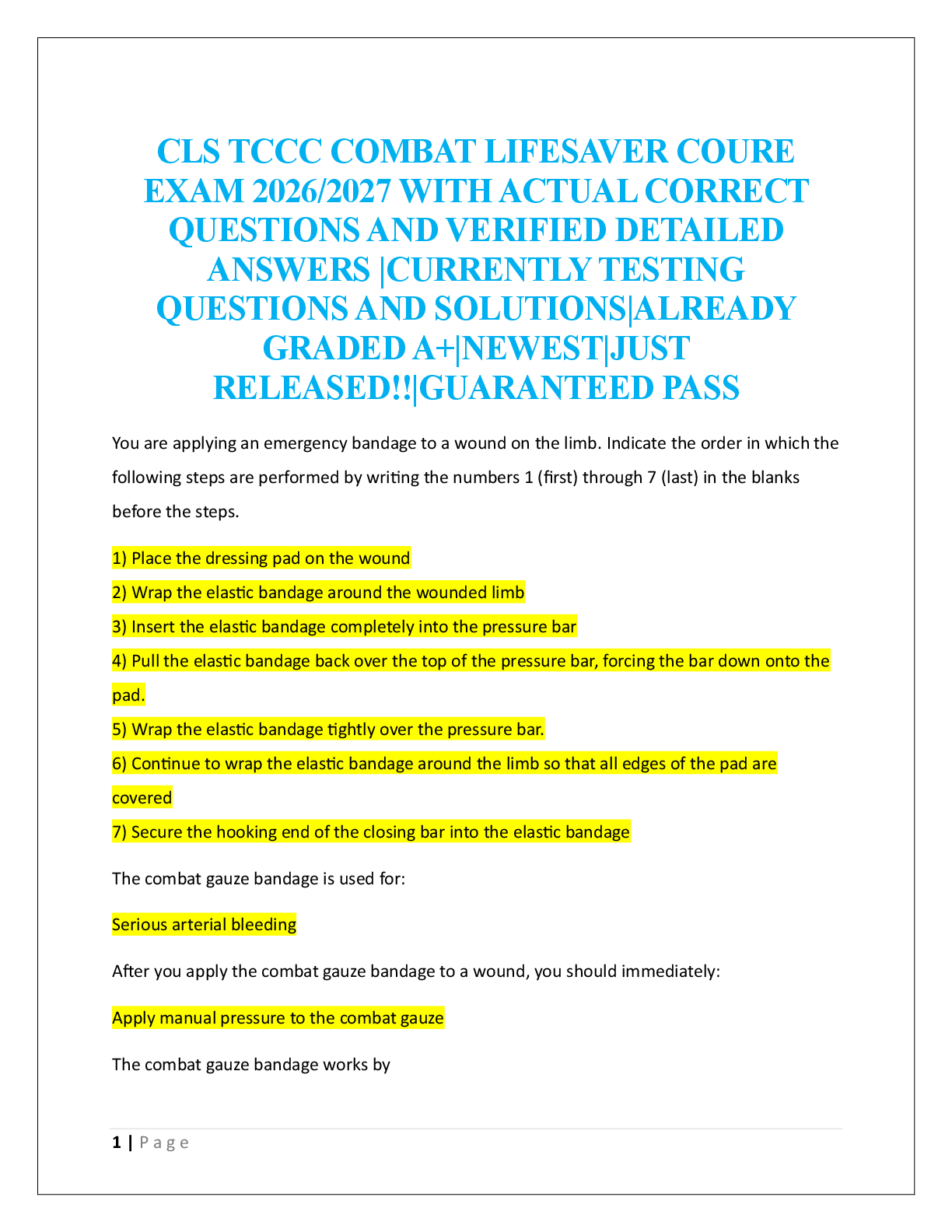c11 CNURSING 295 - Questions and Answers (Latest Version)
Document Content and Description Below
N295 ch 11 MULTIPLE CHOICE 1. The nurse recognizes which of these persons is at greatest risk for undernutrition? 2. When assessing a patient’s nutritional status, the nurse recalls that ... the best definition of optimal nutritional status is sufficient nutrients that: 3. The nurse is providing nutrition information to the mother of a 1-year-old child. Which of these statements represents accurate information for this age group? 4. A pregnant woman is interested in breastfeeding her baby and asks several questions about the topic. Which information is appropriate for the nurse to share with her? 5. A mother and her 13-year-old daughter express their concern related to the daughter’s recent weight gain and her increase in appetite. Which of these statements represents information the nurse should discuss with them? 6. The nurse is assessing a 30-year-old unemployed immigrant from an underdeveloped country who has been in the United States for 1 month. Which of these problems related to his nutritional status might the nurse expect to find? 7. For the first time, the nurse is seeing a patient who has no history of nutrition-related problems. The initial nutritional screening should include which activity? 8. A patient is asked to indicate on a form how many times he eats a specific food. This method describes which of these tools for obtaining dietary information? 9. The nurse is providing care for a 68-year-old woman who is complaining of constipation. What concern exists regarding her nutritional status? 10. During a nutritional assessment, why is it important for the nurse to ask a patient what medica-tions he or she is taking? 11. A patient tells the nurse that his food simply does not have any taste anymore. The nurse’s best response would be: 12. The nurse is performing a nutritional assessment on a 15-year-old girl who tells the nurse that she is “so fat.” Assessment reveals that she is 5 feet 4 inches and weighs 110 pounds. The nurse’s appropriate response would be: 13. The nurse is discussing appropriate foods with the mother of a 3-year-old child. Which of these foods are recommended? 14. The nurse is reviewing the nutritional assessment of an 82-year-old patient. Which of these factors will most likely affect the nutritional status of an older adult? 15. When considering a nutritional assessment, the nurse is aware that the most common anthropo-metric measurements include: 16. If a 29-year-old woman weighs 156 pounds, and the nurse determines her ideal body weight to be 120 pounds, then how would the nurse classify the woman’s weight? 17. How should the nurse perform a triceps skinfold assessment? 18. In teaching a patient how to determine total body fat at home, the nurse includes instructions to obtain measurements of: 19. The nurse is evaluating patients for obesity-related diseases by calculating the waist-to-hip ratios. Which one of these patients would be at increased risk? 20. A 50-year-old woman with elevated total cholesterol and triglyceride levels is visiting the clinic to find out about her laboratory results. What would be important for the nurse to include in pa-tient teaching in relation to these tests? 21. In performing an assessment on a 49-year-old woman who has imbalanced nutrition as a result of dysphagia, which data would the nurse expect to find? 22. A 21-year-old woman has been on a low-protein liquid diet for the past 2 months. She has had adequate intake of calories and appears well nourished. After further assessment, what would the nurse expect to find? 23. The nurse is performing a nutritional assessment on an 80-year-old patient. The nurse knows that physiologic changes can directly affect the nutritional status of the older adult and include: 24. Which of these interventions is most appropriate when the nurse is planning nutritional interven-tions for a healthy, active 74-year-old woman? 25. A 16-year-old girl is being seen at the clinic for gastrointestinal complaints and weight loss. The nurse determines that many of her complaints may be related to erratic eating patterns, eating predominantly fast foods, and high caffeine intake. In this situation, which is most appropriate when collecting current dietary intake information? 26. The nurse is preparing to measure fat and lean body mass and bone mineral density. Which tool is appropriate? 27. Which of these conditions is due to an inadequate intake of both protein and calories? 28. During an assessment of a patient who has been homeless for several years, the nurse notices that his tongue is magenta in color, which is an indication of a deficiency in what mineral and/or vit-amin? 29. A 50-year-old patient has been brought to the emergency department after a housemate found that the patient could not get out of bed alone. He has lived in a group home for years but for several months has not participated in the activities and has stayed in his room. The nurse assess-es for signs of undernutrition, and an x-ray study reveals that he has osteomalacia, which is a de-ficiency of: 30. An older adult patient in a nursing home has been receiving tube feedings for several months. During an oral examination, the nurse notes that patient’s gums are swollen, ulcerated, and bleeding in some areas. The nurse suspects that the patient has what condition? 31. The nurse is assessing the body weight as a percentage of ideal body weight on an adolescent patient who was admitted for suspected anorexia nervosa. The patient’s usual weight was 125 pounds, but today she weighs 98 pounds. The nurse calculates the patient’s ideal body weight and concludes that the patient is: MULTIPLE RESPONSE 1. The nurse is assessing a patient who is obese for signs of metabolic syndrome. This condition is diagnosed when three or more certain risk factors are present. Which of these assessment find-ings are risk factors for metabolic syndrome? Select all that apply. SHORT ANSWER 1. A patient has been unable to eat solid food for 2 weeks and is in the clinic today complaining of weakness, tiredness, and hair loss. The patient states that her usual weight is 175 pounds, but to-day she weighs 161 pounds. What is her recent weight change percentage? To calculate recent weight change percentage, use this formula: Usual weight – current weight 100 usual weight [Show More]
Last updated: 3 years ago
Preview 1 out of 12 pages
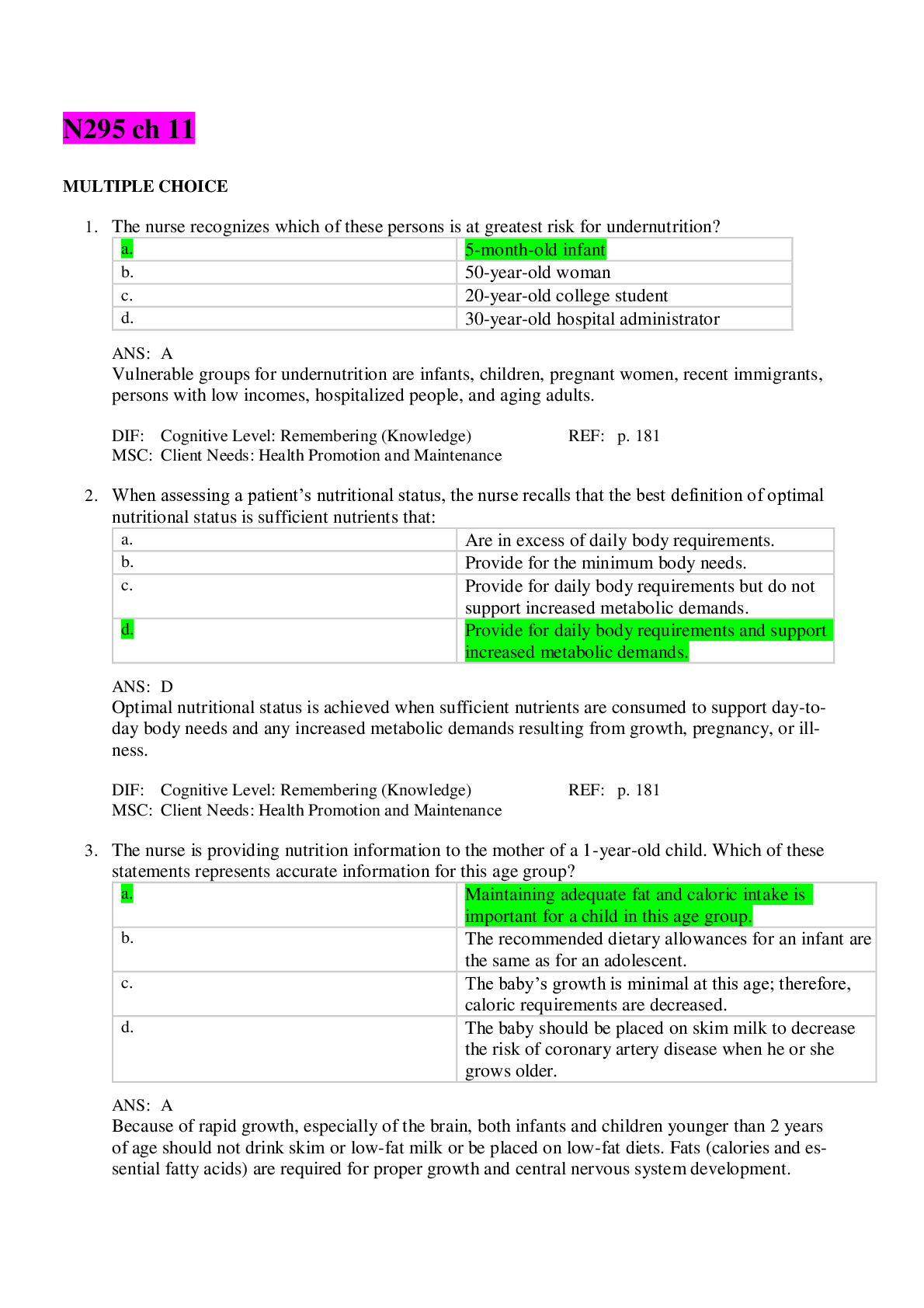
Buy this document to get the full access instantly
Instant Download Access after purchase
Buy NowInstant download
We Accept:

Also available in bundle (1)
Click Below to Access Bundle(s)

CNURSING 295
CHAPTER 23 NEUROLOGIC SYSTEM,CHAPTER 21 ABDOMINAL ASSESSMENT,N295 EXAM 4,N295 EXAM 3,c22,c21,c19,c18,c17,c16,c15,c14,c13,c12,c11,c10,c9,c8,c7,c6,c5,c4,c2,c1
By Ajay25 4 years ago
$75
24
Reviews( 0 )
$15.00
Can't find what you want? Try our AI powered Search
Document information
Connected school, study & course
About the document
Uploaded On
Jan 17, 2021
Number of pages
12
Written in
All
Additional information
This document has been written for:
Uploaded
Jan 17, 2021
Downloads
0
Views
120


